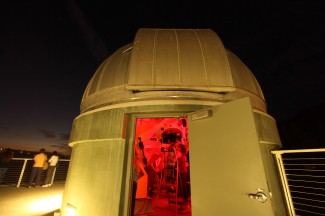Viewing to Feature Mars, Celestial Hot Dog
By
Westmont

Mars, the red planet, will be the focus for stargazers at a free, public viewing with the powerful Keck Telescope Friday, April 20. The event, which begins about 8 p.m., lasts several hours. The observatory opens its doors to the public every third Friday of the month in conjunction with the Santa Barbara Astronomical Unit, whose members bring their own telescopes to Westmont for the public to gaze through. In case of inclement or overcast weather, please call the Telescope Viewing Hotline at (805) 565-6272 and check the Westmont website to see if the viewing has been canceled.
Westmont physics instructor Thomas Whittemore says Mars will lie in the constellation Leo that evening. “It’ll only be about 11 arc seconds in diameter, so seeing any detail on the red planet will be difficult,” he says. “Only under the steadiest seeing conditions will we have any hope of getting a glimpse of any detail on Mars, but we will try.”
While the telescope is still pointing up in the direction of Leo, Whittemore says he’ll aim the Keck Telescope beyond Mars and into the realm of the galaxies. “Among the spring’s finest galaxy groupings is the Leo Trio, a triplet of galaxies that includes M65, M66 and NGC3628,” he says. “Lying some 35 million light-years away, NGC3628 is a spiral galaxy discovered by Sir William Herschel in 1784. With a diameter of 300,000 light-years, it has about three times the extent of our own Milky Way Galaxy. Since we see it edge-on, it shows a wonderful dust lane that divides the galaxy in half, making it look like a cosmic hot dog.”
The viewing may also include two contrasting, open clusters in Cancer, the crab. “One of these, M44, also known as the Beehive Cluster, was first seen in a telescope by Galileo in 1609,” Whittemore says. “He counted about 40 stars in this spectacular gem, second only in its dazzle to the Pleiades. The stars in M44 are somewhat young by stellar standards, estimated to be about 600 to 700 million years old.”
Westmont students and faculty use the 24-inch reflector telescope to conduct astronomical research. The Keck Telescope is housed in the observatory between Russell Carr Field and the track and field/soccer complex. Free parking is available near the baseball field.
Filed under
Campus Events, Campus News, Faculty and Staff, Press Releases